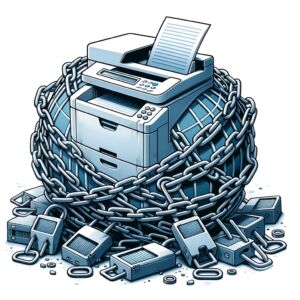In today’s fast-paced business environment, efficient document handling is quintessential. Among the plethora of printing solutions, printer pooling is a term that often surfaces. But what exactly is printer pooling? And how does it fit into the larger picture of print management?
This guide explains the concept of printer pooling, its traditional framework, and introduces a superior and more efficient solution, OM Plus Load Balancing, that transcends the conventional boundaries of printer pooling. We’ll explore how OM Plus Load Balancing overcomes the limitations of traditional printer pooling, offering a streamlined, cost-effective, and secure printing environment for modern enterprises.
What is Printer Pooling?
Printer pooling is a configuration that combines multiple printers into a single, cohesive unit known as a pool. When a print job is sent to the pool, it is delegated to the first available printer, ensuring a swift printing process devoid of unnecessary queues. This mechanism not only expedites print jobs but also serves as a contingency plan, rerouting tasks to operational printers should one face technical glitches.
How does Traditional Printer Pooling Work?
Traditional printer pooling operates on a straightforward principle: combining the capacities of various printers to handle print jobs more efficiently. Here’s how it unfolds:
- Configuration: Multiple printers are grouped into a singular pool, typically managed by a print server.
- Job Allocation: When a print job is initiated, the server dispatches it to the first available printer in the pool.
- Fallback Mechanism: In case a printer in the pool is inoperative, the job is seamlessly redirected to the next available printer.
This rudimentary setup augments print efficiency to a certain extent, yet, it’s not devoid of limitations.

Limitations of Traditional Printer Pooling
Traditional printer pooling, while pragmatic, encounters several bottlenecks:
- Overage Costs: Printers with higher page capacities might remain underutilized, leading to overage costs.
- Uneven Distribution: Print jobs aren’t always distributed evenly, causing some printers to wear out faster.
- Security Concerns: The lack of isolation between printers could potentially breach print security.
- Scalability Issues: As the enterprise grows, the static nature of traditional pooling struggles to keep up.
These constraints necessitate a more robust solution. This is where OM Plus Load Balancing comes into play.
What is OM Plus Load Balancing?
OM Plus Load Balancing is a streamlined solution that evolves the concept of printer pooling to new heights. It’s not merely about grouping printers together; it’s about intelligently distributing print jobs to optimize usage, reduce costs, and enhance security.
How does OM Plus Load Balancing Improve Upon Traditional Printer Pooling?
OM Plus Load Balancing employs advanced algorithms to ensure a more equitable distribution of print jobs across the printers in a pool. Here’s how it surpasses traditional printer pooling:
- Smart Distribution: Unlike traditional pooling, OM Plus distributes print jobs evenly to prevent bottlenecks and ensure optimal usage.
- Cost Efficiency: By maximizing the utilization of each printer, OM Plus curtails overage costs, contributing to a more economical print environment.
- Enhanced Security: OM Plus can isolate printers, ensuring that sensitive documents are printed securely.
- Customization: Unlike traditional printer pooling, OM Plus can be tailored to meet your particular needs and your environment.
Benefits of OM Plus Load Balancing
Saves Money by Reducing Overage Costs
OM Plus Load Balancing meticulously allocates print jobs, ensuring that each printer is utilized to its fullest potential. This sensible distribution of tasks reduces the chances of incurring overage costs, thus rendering a cost-effective printing ecosystem.
Improves Print Efficiency by Distributing Print Jobs Evenly Across Printers
With its intelligent job allocation, OM Plus eradicates the pitfalls of uneven distribution, a hallmark of traditional printer pooling. It ensures that no printer is overburdened while others remain underutilized, thus promoting a balanced and efficient print environment.
Enhances Print Security by Isolating Printers from Each Other
Security is paramount in today’s digital realm. OM Plus Load Balancing provides the feature of isolating printers, ensuring that sensitive documents are printed securely without inter-printer vulnerabilities.
Provides a More Robust and Reliable Print Environment
By mitigating the limitations inherent in traditional printer pooling, OM Plus Load Balancing paves the way for a robust, reliable, and streamlined print management infrastructure, suitable for modern enterprises.
How to Implement OM Plus Load Balancing
Steps to Set Up an OM Plus Load Balancing Pool
- Analysis: Conduct a thorough analysis of your print environment to ascertain the number and types of printers to be included in the pool.
- Configuration: Utilize the OM Plus dashboard to create a new printer pool which is called a Class in OM Plus.
- Printer Addition: Add the selected printers to the Class, configuring their settings as per the organizational requirements.
- Load Balancing Settings: Define the load balancing criteria, ensuring a balanced distribution of print jobs across the printers.
- Testing: Run a series of tests to ensure the setup works as intended, making any necessary adjustments.
Best Practices for Managing an OM Plus Load Balancing Pool
- Regular Monitoring: Monitor the performance of the printer pool regularly to ensure optimal operation.
- Maintenance: Schedule routine maintenance to keep the printers in top-notch condition.
- Security Checks: Conduct security audits to ensure that the isolation feature is functioning as intended, maintaining a secure print environment.
Cost of OM Plus Load Balancing
Factors That Affect the Cost of OM Plus Load Balancing
- Number of Printers: The number of printers within the pool could affect the overall cost.
- Complexity of Configuration: A more complex configuration may entail a higher cost.
- Maintenance and Support: Ongoing maintenance and support services might incur additional charges.
How to Get a Quote for OM Plus Load Balancing
OM Plus Load Balancing transcends traditional printer pooling, offering a robust, efficient, and secure print management solution. By intelligently distributing print jobs, reducing overage costs, and enhancing print security, it significantly upgrades the print environment of modern enterprises.
Reach out to a representative today, providing details about your print environment, to receive a tailored quote that aligns with your specific needs.



